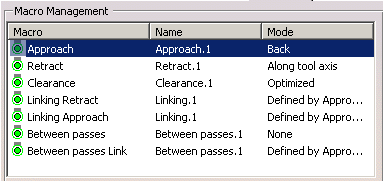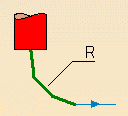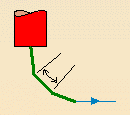| |
With the exception of the Roughing,
that offers only the Build by user graphic mode for pre-and
post-macros in addition to automatic macros, and
Isoparametric Machining operations, you are offered three different
methods to add macros:
- the catalog method, by using macros already built and stored in a
catalog. For more information on how to save or load an existing macro,
please refer to
Build and use a macros catalog.
- the graphic method, by using the macros proposed by the application.
It is a quick method, that does not require the definition of the
parameters. However, you can double-click the representation of the macro,
or use its contextual menu, to tune up the parameters.
- the numeric method, by defining the macros parameters.
The numeric method corresponds roughly to the method offered in the
previous releases.
Click  to switch from
the graphic mode to the numeric mode. to switch from
the graphic mode to the numeric mode. PP Words can be inserted. Please see
Defining Macros for more
information. |
| |
|
|
| |
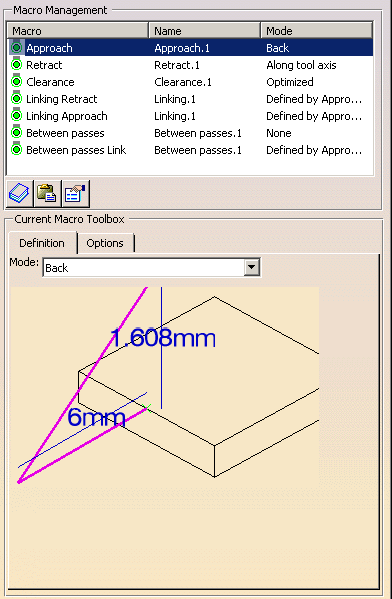 Dialog box in the graphic
method |
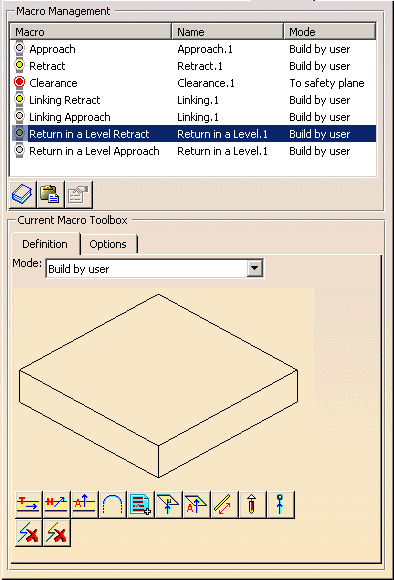 Dialog box in the
graphic method, using the Build by user macros |
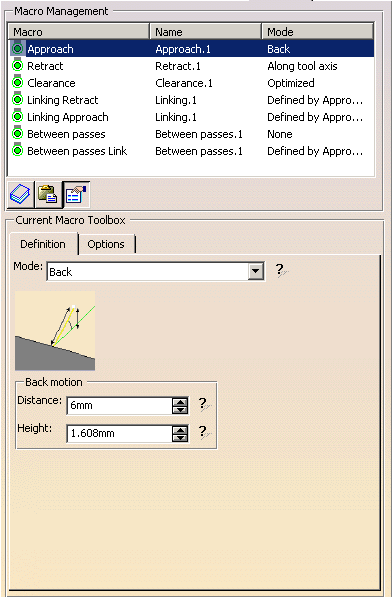
Dialog box in the numeric mode |
| |
With the cursor in the viewer window of the
dialog box, you can zoom in and out and pan the paths.
Place your cursor
on a portion of the macro path. Right click to display the contextual menu.
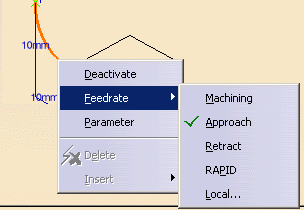
-
Delete and Insert are available for
the Build by user macros.
-
The parameters dialog box can also be launched by
double-clicking a portion of the path in the viewer.
-
You can also double-click a label in the viewer. This will
start the Edit dialog box of the corresponding parameter.
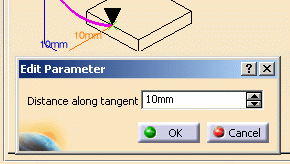
|
 |
The graph displayed in the viewer of the dialog box is a
generic representation of a macro mode.
It is not the true representation of the macro you are using or defining. To
check the result of you settings, press Replay. |
| |
For each operation, you can define the following macros:
- Approach,
- Retract,
- Linking Retract,
- Linking Approach,
- Clearance,
- Between passes (not available for Spiral Milling, Pencil),
- Between passes Link (not available for Spiral Milling,
Pencil, ZLevel).
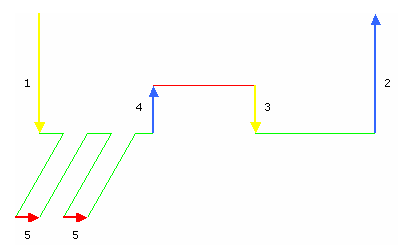
|
 |
Note that Between Passes has been split into
Between passes and Between passes Link.
Between passes
Link corresponds to the highlighted portion of the path below:
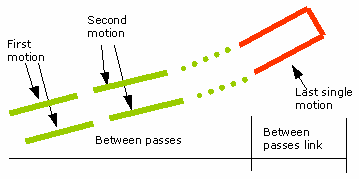 |
| |
The macros are listed as follows:
- In the Macro column, you find the type of the macro,
- In the Name column, you find the name of the macro,
- In the Mode column, you find the machining mode of the
macro.
By default, the application has affected a machining mode to each macro:
To affect another machining mode to a macro, select the macro line in the
Macro Management frame,
then select a machining mode in the Mode list.
Here are the available modes:
For Approach, Retract, Between passes:
- Along tool axis,
- Along a vector,
- Normal,
- Tangent to movement,
- None,
- Back,
- Circular,
- Box,
- Prolonged movement,
- High speed milling
(not available for Sweep Roughing, Spiral Milling, Pencil),
- Build by user.
For Linking Retract, Linking Approach:
- Along tool axis,
- Along a vector,
- Normal,
- Tangent to movement,
- None,
- Back,
- Circular,
- Box,
- Prolonged movement,
- High speed milling
(not available for Sweep Roughing, Pencil),
- Defined by
Approach/Retract,
- Build by user.
For Clearance:
For Between passes Link (not available for Pencil):
|
 |
Note that the Circular macro
corresponds to the former one, with an automatic definition of the plane,
while Add circular within a plane motion correspond to the former
one, with a manual definition of the plane. |
 |
To avoid inconsistencies, ZLevel
operations offer only the relevant macros:
- Approach,
- Retract,
- Linking Retract,
- Linking Approach,
- Clearance,
- Between passes,
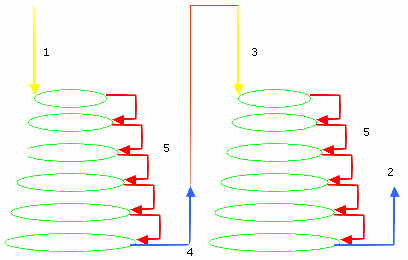
and their associated machining modes:
For the same reason, the items of the contextual menu may be limited to
the relevant ones. |
 |
- If the defined motion does not belong to the Z plane, the normal
projection of the motion is taken into account.
- For To a point, if the point is defined inside the
material, the tool path cannot be computed, an error message is displayed.
- In the Defined by Approach/Retract mode, the between pass
motion is replaced by a linking retract motion and a linking approach
motion.
|
| |
Graphic mode
Double-click a macro path or a geometry element to modify the macro path
or the geometry.
Double-click a parameter label to display the edition dialog box to
modify the value of this parameter only (since those dialog boxes are
standard edition boxes, they are not shown below).
Information specific to the graphic mode are displayed on this background
color. |
Numeric mode
Type the required value in the field.
Use the interrogation mark to launch the graphic help.
Information specific to the numeric mode are displayed on this background
color. |
| |
Along
tool axis: The tool moves along the tool axis for a given
Axial motion Distance, |
| |
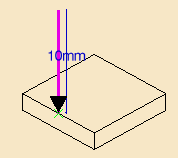
Double-click the violet line to edit the Axial motion,
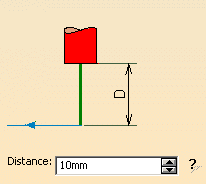
|
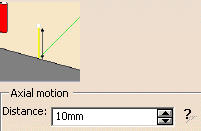
Type the Axial motion Distance value.
|
 |
For ZLevel operations only: If you set the
Between passes mode to Along tool axis and the
Clearance mode to Optimized, the tool will move in the
current plane, as far as possible, and not rise along the tool axis.
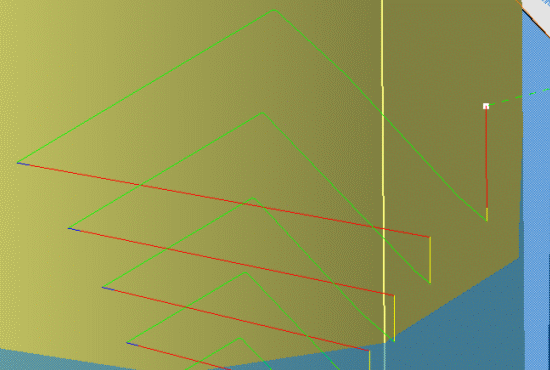
This tool path will consist of:
- a motion in retract speed,
- then a motion in high speed,
- then an approach motion.
This motion is collision free and does not take the Distance
parameter of the optimized clearance into account.
If you want to ignore the optimized clearance in the Between passes,
set the Between passes mode to Defined by Linking
Approach/Retract. |
| |
Along a
vector The tool moves along a vector (line motion) for a given
Distance, |
| |
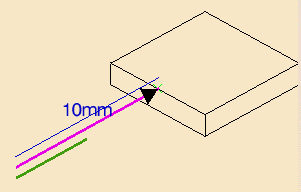
Double-click the green line to edit the direction.|
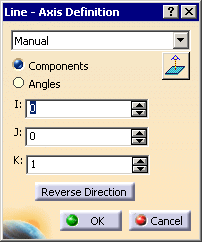
Double-click the violet line to edit the Distance
along the line motion,

|
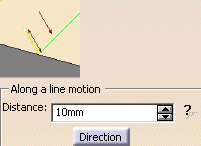
Type the Distance value.
Click Direction to edit the vector direction.

|
| |
Normal
The tool moves in a direction perpendicular to the surface being machined (Perpendicular
motion), for a given Distance, |
| |
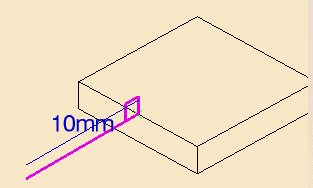
Double-click the violet line to edit the distance in the
Perpendicular motion,
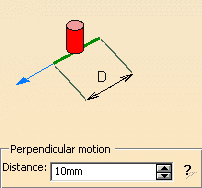
|
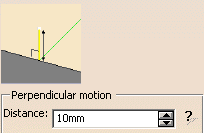
Type the Perpendicular motion Distance.
|
| |
Tangent to movement The tool motion is tangent at its end to the
rest of the toolpath and is of a given Distance, with a vertical
angle and a horizontal angle. |
| |
-
vertical angle
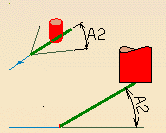
-
horizontal angle
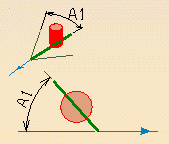
|
|
| |
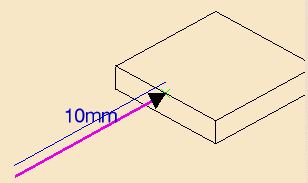
Double-click the violet line to edit the Distance
and the Vertical angle and
Horizontal angle.
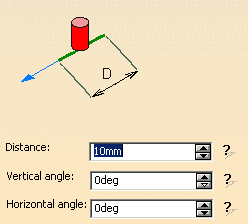
|
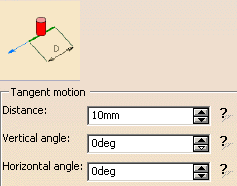
Type the
Distance and the Vertical
angle and Horizontal
angle. |
| |
None
No approach nor retract macro is applied. Note that when this macro is
selected on Approach or Retract, no Link to Safety
Plane is added, as shown below.
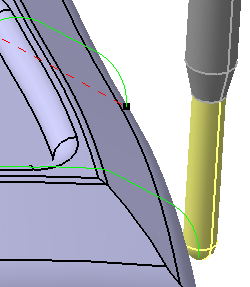
If you require a Link to Safety Plane, select Along tool axis
with an axial motion Distance value equal to 0 mm. This is what
you will get:
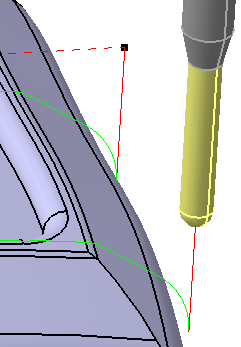
(This is not available with an isoparametric machining operation.) |
| |
Back
The tool doubles back like an arrow above the cutting tool path (Back
motion). You can either define this type with a Distance
and a Height. |
| |
- Distance

- Height
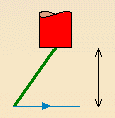
|
| |
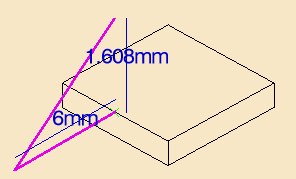
Double-click the violet line
to edit the Distance and the Height
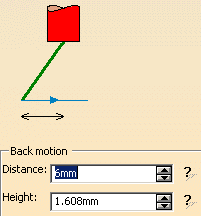 |
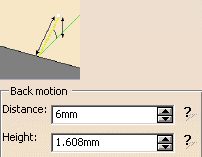
Type the Distance
and the Height |
 |
When you type a Distance higher than
the cutting tool path to which the macro refers, a tool path Along Tool
Axis is added, its length being equal to the difference between
Distance and the length of the cutting tool path.
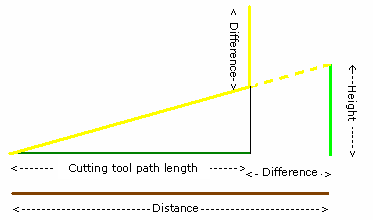 |
| |
Circular
The tool moves towards/away from the part in an arc (Circular
motion). The parameters that you can set are:
- For the Circular motion:
- The Axial motion Distance
If you do not use Part autolimit, the curve will be below the
surface of the part.
-
Angular sector
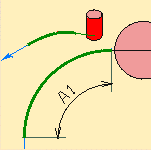
-
Angular orientation
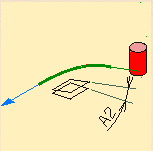
-
Radius
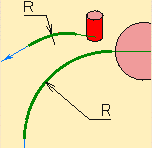
|
| |
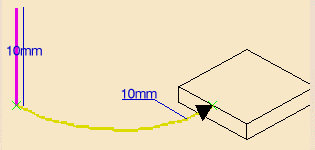
Double-click the arc (yellow line) to edit the Circular
motion:
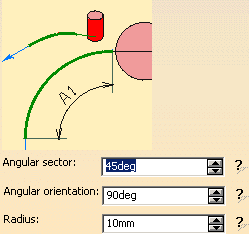
Double-click the violet line to edit the Axial motion
Distance.
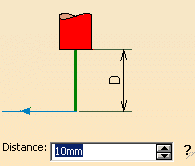
|
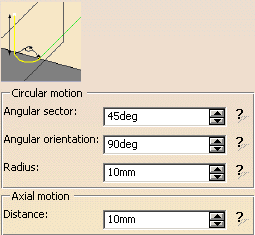
Type the Angular sector, the Angular
orientation, the Radius and the Axial motion Distance.
|
 |
- Note that the Circular macro can automatically modify the
Angular orientation defined by user to avoid collisions.
- If collisions cannot be avoided, then the Prolonged Movement
Macro replaces the Circular macro.
- For ZLevel, the Angular sector cannot exceed 180 degrees.
|
| |
Ramping
The tool follows a slope defined by the ramping angle.
The parameters to define are the Axial motion Distance and the
Ramping angle. |
| |
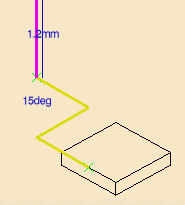
Double-click the violet line to edit the Axial motion
Distance:

Double-click the yellow line to define the Ramping
angle:
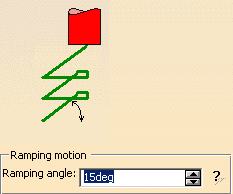
|
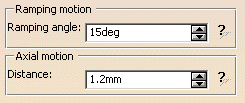
Type the Ramping angle and the Axial motion
Distance.
|
| |
Circular or ramping The tool uses either circular or ramping
mode depending on whichever is best adapted to the part being machined.
The Circular or
ramping motion is defined by
-
Angle
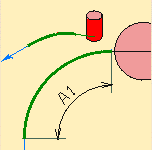
-
Radius
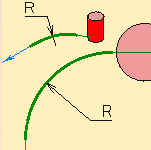
-
Ramping angle

|
| |
The Prolonged motion is defined by:
- Length
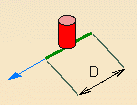
- Angle
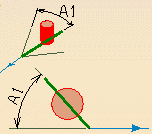
|
| |
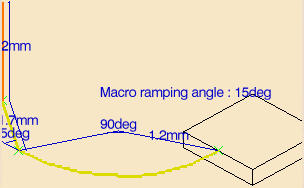
Double-click the
orange line to edit the Axial motion Distance

Double-click the inclined yellow line to edit the Prolonged motion:
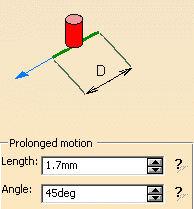
Double-click the arc to edit the Circular or ramping motion:
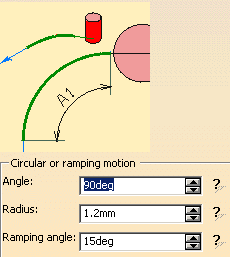 |
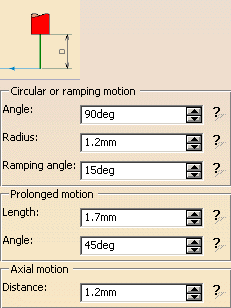
Type the Angle, Radius and
Ramping angle for the Circular or ramping motion,
the Length and Angle for the
Prolonged motion and the Axial motion Distance.
|
 |
For ZLevel, the Angular
sector cannot exceed 180 degrees. |
| |
Box
The tool moves across the diagonal of an imaginary box (Box
motion), either in a straight line or in a curve (Linking
mode).
The Box motion is defined by:
The Axial motion Distance is the distance that the tool will
move in once it has crossed the box.
- Distance along the tangent
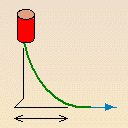
- Distance along the tool axis
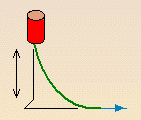
- Distance along the normal axis
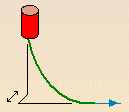
|
| |
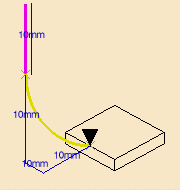
Double-click the violet line
to edit the Axial motion Distance:

Double-click the arc (yellow line) to edit the Box motion:
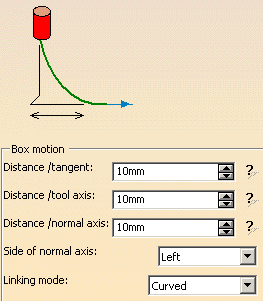 |
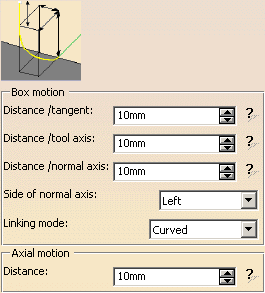
Type the values of the
Distance/tangent, Distance/tool axis, Distance/normal
axis, and of the Axial motion Distance.
Choose from the list which side of the normal axis will determine the
direction of the diagonal of the box.
Select a Linking mode (Curved or Straight). |
| |
Prolonged movement The
tool moves in a straight line that may slant upwards.
The Prolonged motion is defined by:
- the Distance,
- the Vertical angle,
- the Horizontal angle,
The Axial motion is defined by the Distance.
The advantage of this mode is that collisions are automatically detected.
In the event that a possible collision is detected, the angle will be
adjusted to avoid collision. If the angle cannot be adjusted (because of the
shape of the part, for instance), the length of the prolongation will be
automatically adjusted to avoid collision.
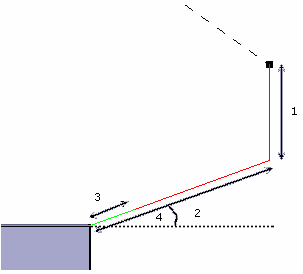
- Tangent motion Distance
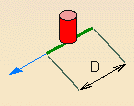
- Tangent motion Vertical angle,
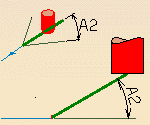
- Axial motion Distance
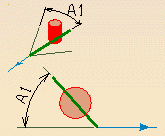
|
| |
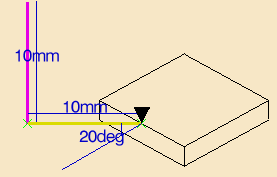
Double-Click the violet
line to edit the Axial motion Distance

Double-click the yellow line to edit the Tangent motion:
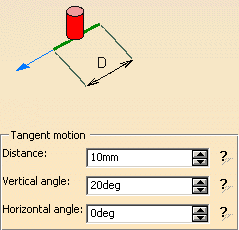 |
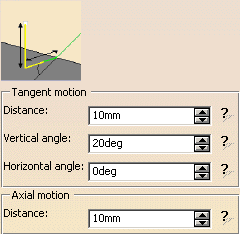
Type the Distance, the Vertical angle,
the Horizontal angle and the Axial motion
Distance.
|
| |
High speed milling
The parameters are:
|
| |
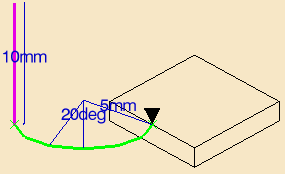
Double-click the violet line to edit the Axial motion
Distance:

Double-click the green arc to edit the High Speed
Milling motion
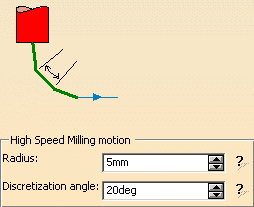
|
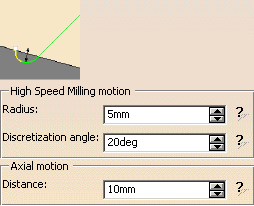
Type the Radius
and the Discretization angle defining the High Speed Milling
motion, and the Axial motion Distance. |
| |
Defined by Approach/Retract,
Defined by Approach The
macro used for the Linking Retract, Linking Approach or Between passes Link
is that used for the Approach or the Retract. |
Build by user
(available in graphic mode only - see the
Sweeping User Task for
more information on the operating mode)
Predefined macros are proposed
through the following icons. You can create a machining path by adding
several predefined macros. The current one is colored violet.
If necessary, you can double-click the line representing the macro to
edit its parameter, or the associated geometry representation to edit this
geometry. |
| Icon |
Representation |
Name |
Available
dialog boxes |
 |
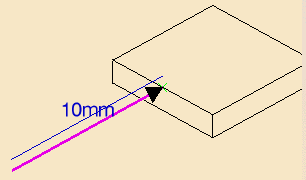
|
Add Tangent motion |

|
 |
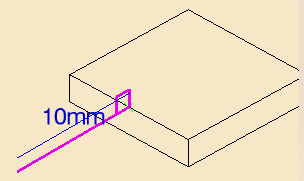
|
Add Horizontal motion |

|
 |
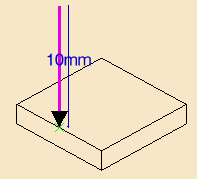
|
Add Axial motion |

|
 |
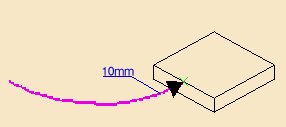
|
Add Circular motion see
also Circular |

|
 |
See Defining Macros |
Add PP word list |
|
 |
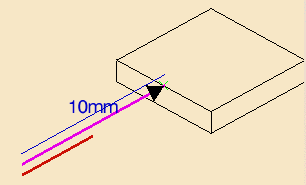
|
Add distance along a
line motion See also
Along a vector
|
  |
| |
|
|
Note that in ZLevel, this macro can be created alone of with
Add axial motion only. |
 |

|
Add normal motion See also
Normal |

|
 |
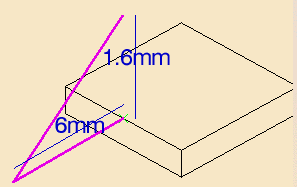
|
Add back motion See also
Back |

|
 |
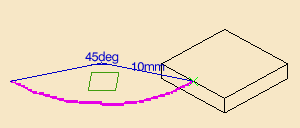
|
Add circular within a
plane motion |
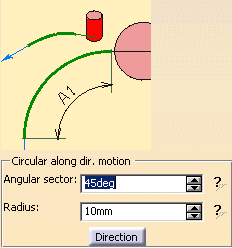 
|
 |
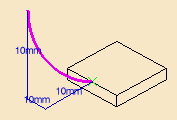
|
Add box motion See also
Box |
 |
 |
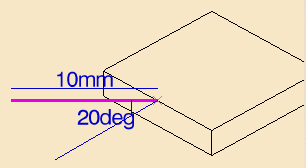
|
Add prolonged motion
see also Prolonged movement |
 |
 |
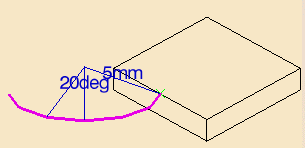 |
Add high speed milling
motion See also
High speed milling |
 |
 |
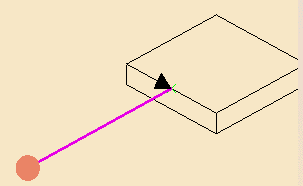 |
Add motion to a point |
Available in ZLevel - build by user mode.
Click the point on the icon, the dialog box disappears.
Select a point in the graphic area.
Note that this macro can be created alone of with Add axial
motion only. |
 |
|
Keep machining feedrate |
Applies the
machining feedrate to all the macro paths. |
 |
|
Remove all motions |
|
 |
|
Delete selection motion |
|
|
|
|
|
Optimized This means that if no
obstacle is detected between two passes, the tool will not rise to the
safety plane (because it is not necessary) and the operation will take less
time. In some cases (where areas of the part are higher than the zone you
are machining and when you are using a safety plane), the tool will cut into
the part. When this happens, choose another clearance mode.
In both modes, you can only edit the Distance parameter by
double-clicking the label.
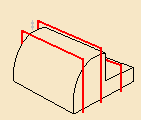
Along tool axis
The tool moves up to the defined safety plane along the tool
axis. If no safety plane is defined, the safety plane is the upper point of
the part.
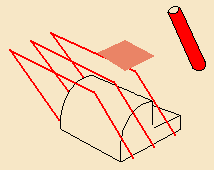
Perpendicular to
safety plane
The tool moves up to the defined safety plane along an axis perpendicular
to the safety plane. If no safety plane is defined, the safety plane is the
upper point of the part.
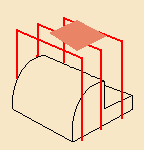
Straight
The tool goes directly to the next path.
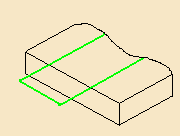
|
![]() to switch from
the graphic mode to the numeric mode.
to switch from
the graphic mode to the numeric mode.






